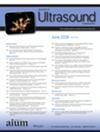Pilot Study to Evaluate the Association Between Superb Microvascular Imaging (SMI) and Histologic Markers of Angiogenesis in Patients With Invasive Ductal Carcinoma
Abstract
Objectives
Increasing microvessel density and angiogenesis are linked to a poor prognosis in patients with invasive ductal carcinoma (IDC) of the breast. This study aims to investigate intratumoral and peritumoral microvascular flow using superb microvascular imaging (SMI) in patients with IDC and explore its association with histologic markers of tumoral angiogenesis.
Methods
Fifty-four female patients with IDC (mean age 49.5 ± 14.8 years) were evaluated using SMI before biopsy. The quantitative and qualitative vascular parameters on SMI (Adler's classification, vascular index, morphology, distribution, and penetration) were assessed. Histologic markers of angiogenesis (VEGF, ERG, and CD34) were analyzed via immunohistochemical staining in both intratumoral and peritumoral compartments of biopsy specimens. The expression levels were categorized semi-quantitatively as low or high groups based on the Allred scoring system. The association between histological and SMI parameters was analyzed. Subgroup analysis was performed according to lesion size, axillary lymph node metastasis, and histological grade.
Results
IDCs with higher expression of VEGF in the peritumoral region showed a higher vascular index (7 ± 6.4 [95% CI 5.2–8.8] versus 3.7 ± 0.9 [95% CI 2.3–5.2], P = .003) on SMI. Likewise, high peritumoral ERG expression was linked to a higher vascular index (7.2 ± 6.3 [95% CI 5.4–9.0] versus 2.4 ± 1 [95% CI 1.1–3.8], P < .001), complex vessel morphology (66.7% versus 20%, P = .024), penetrating vessels (63% versus 20%, P = .037), and central vascularity (77.6% versus 20%, P = .006). Tumors with higher intratumoral ERG expression demonstrated a more complex vessel morphology on SMI (85.7% versus 60%, P = .047). The presence of axillary lymph node metastasis was associated with a higher vascular index (10 ± 7.6 [95%CI 6.7–13.2] versus 4.2 ± 3 [95%CI 3.1–5.3], < .001), complex morphology (83.3% versus 53.3%, P = .020), and penetrating vessels (63.2% versus 50%, P = .027) on SMI, as well as higher peritumoral ERG expression (100% versus 83.3%, P = .045).
Conclusions
In this pilot study, tumors with higher neo-angiogenic activity based on histological markers correlate with increased vascular index, complex vessel morphology, penetrating vessels, and central vascularity on SMI. Larger studies are needed to assess the diagnostic accuracy and utility of risk stratification of patients.

 求助内容:
求助内容: 应助结果提醒方式:
应助结果提醒方式:


